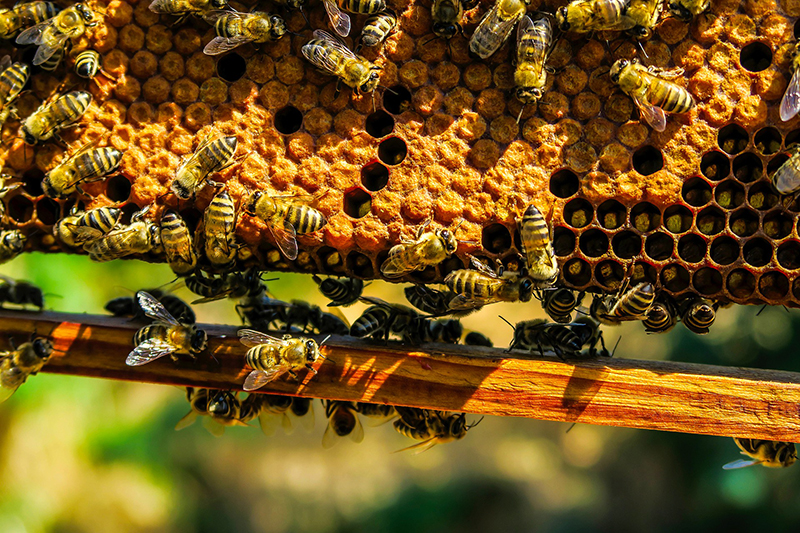Before you apply or invest in bees and equipment:
The intention of the program is to support urban beekeeping as a hobby and non-commercial activity. You are not permitted to sell bees, honey, wax or any other beekeeping products under this program.
Main page content begins here

Beekeeping is a completely safe activity in residential areas with good management practices and provides valuable educational and recreational opportunities for people to connect to nature and to our food system.
Keeping bees in Edmonton is controlled and enforced under the Animal Licensing and Control Bylaw (See Bylaws - A)
The intention of the program is to support urban beekeeping as a hobby and non-commercial activity. You are not permitted to sell bees, honey, wax or any other beekeeping products under this program.
Prior to submitting an application, every beekeeping applicant must notify all immediately surrounding neighbours, including those attached to their property or across an alleyway, in writing, of their intent to keep bees. This requirement is a notification to neighbours, not a request for permission. Your neighbours have 2 weeks to respond to the City of Edmonton with any concerns after receiving the letter.
Submit all letters as part of your application. Please note the date and addresses on copies of the letters that were given out in your application. We do not require that the letters be signed, however, copies of the letters you sent with the date and address indicated on the letter need to be submitted with your online application.
Do not submit your online application until you have given your neighbours 2 weeks to respond to the letter from the date it was sent.
If you do not submit all required notification letters as a part of your online application, those who did not receive the letter will be given another 2 weeks to respond so double-check that you have notified all the required properties.
In the case where neighbouring properties are apartment buildings or businesses, building managers and business owners are to receive the notification letter.
The Urban Beekeeping Guidelines help residents understand the expectations that the City has for beekeepers. Interested beekeepers will also benefit from connecting with the beekeeping community and talking to existing beekeepers to learn more about what it takes to keep bees in the city.
As part of the Animal Health Act, owners of bees must have a premises identification account and premises identification number for the bees. This requirement is a part of a traceability system designed to address potential threats of disease outbreaks that could affect animal health, public health and food safety.
All interested beekeepers must submit an online application outlining the following requirements:
As a part of the Bee Act and Regulation, beekeepers must register with the Provincial Apiculturist every year by June 30.
Each approved beekeeper and the property owner and/or a resident of the site must complete a beekeeping course from an accepted organization/association.
Beekeepers in their first year are recommended to have the support and assistance of an experienced beekeeper.
Every beekeeper shall adhere to good management and husbandry practices and maintain bees in such a condition so as to prevent swarming, aggressive behaviours and disease. Animal Control must be notified of any swarms and/or disease and the steps taken to rectify the issue.
Approved beekeeping site owners shall make themselves and the hive(s) available for inspection on reasonable request of Animal Control Peace Officers.
Should Animal Control find a site, hive or beekeeper to be unsuitable at any time, the permission may be revoked and the site owner shall work with Animal Control to relocate the hive and bees to a location outside the City of Edmonton. All costs and associated expenditures related to the removal are the sole responsibility of the site or property owner. Permission can be revoked due to documentation of medical concerns from residents of neighbouring properties.
Animal Control Peace Officers will respond to all complaints and initiate investigations when warranted. Failing to comply with the terms and conditions of an Urban Beekeeping Licence may result in a fine of $100, or a licence being revoked. Keeping bees without a licence will result in a $500 fine. Honey production is for self-consumption. No sale of honey and bee products is permitted.
All public complaints shall be directed through 311; this reporting approach is consistent with the City of Edmonton bylaw complaint process. Failing to comply with the terms and conditions of an Urban Beekeeping Licence may result in a fine of $100, or a licence being revoked. Keeping bees without a licence will result in a $500 fine.
Individuals can take any of these intensive beginner courses offered by City-approved organizations and associations to receive a beekeeping certificate.
Courses Offered: Introduction to Urban Beekeeping Certification
Delivery: In-person
Course Offered: BEKP100 - Level 1 Beekeeping
Delivery: Virtual/Online
Course Offered: BeeComm
Delivery: Virtual/Online
Course Offered: Beekeeping for Beginners
Delivery: In-person
Applicants who have been in good standing in the program for at least 2 years may apply to have a second hive.
Applicants who wish to have a second hive can inquire through 311 with a revised site plan indicating the placement of their proposed hive.
A swarm of honey bees is not dangerous. Swarms typically occur when about half of the bees in a colony leave with the queen to form a new colony. Swarming is the natural means of reproduction for honey bee colonies.
In the event that a honey bee swarm lands on your property, call 311 to inform the City.
For assistance with:
If you are calling from outside of Edmonton: 780-442-5311
| Phone | 311 |
|---|